Success Factors of Information Technology Projects, Essay Example
Different projects emphasize different requirements. Nevertheless, all projects are limited by the time, cost, and the scope of the business constraints. In this investigation, the limitations are the key requirements for having a more successful project management. With the framework of the business factor, the survey provides answers to the aims or objectives of the project that needs to be satisfied with the project’s success. The time factor is concerned with the amount of time that is required for the project completion (Cattani, et al, 2011). Lastly, the cost or budget constraint access the cost needed for the completion of the project (Philipps, 2003). The successful project is therefore measured by the extent to which the goals for the three factors as well as the consumer satisfaction can be achieved.
The top performing projects establish a better view of initiative’s strategic value. It should go beyond just the technical content. By having a robust business case together with maintaining the focus on the business objectives within a defined business timeline, the cost overruns can be well avoided. Some typical examples include ensuring the customer response time is faster, obtaining a higher-quality data for a given marketing organization and reducing the number of manual processes required.
The outcomes of IT projects corresponding with plans vs. IT projects keep their timetables
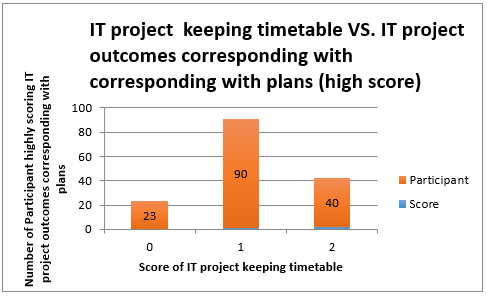
Chart 1: The high score part of IT project outcomes corresponding with plans correlate to project timetable.
The chart presented herein shows how important scheduling is when it comes to identifying the future success of a project. Sticking to the timetable of a project’s planned operation creates a more conducive process of completing the objectives set by the team to reach. A better planning of the project’s scope is a complicated process, especially where the organization needs to control monetary expenses as the project is being planned for and carried on for completion. Formulating the time table of the project’s completion entails to make a distinct impact on how the resources are to be used for the best results as defined in the primary objectives of the plan. The findings from the Levene’s test in combination with the ANOVA, Pearson correlation, and t-test suggests a strong relationship between the variables affecting the overall result of the project (Philipps, 2003).
Project outcomes are usually aligned alongside the objectives set by the organization. However, there are instances when some core factors result to change in the project’s timetable. Another element to consider is that resource availability influences the of the project’s completion; the lesser the availability of resources, the longer the project schedule. Handling complex projects also affect scheduling, hence, this makes project manager seek out better alternatives to make sure objectives and goals are met accordingly. Sometimes, various functions cannot commence without others getting finished, and therefore situations arise when some tasks have begun together. In a concise consideration, the task dependencies factor dictates the order of tasks as well as dictating the need of the project for resources at any given point.
The inaccurate predictions that are usually done by the project stakeholders who are over-optimistic about the time are taken for the team members to finish their tasks. Physical resources such as the installation of the networking systems tend to consume more time than expected. The need for adjustment of the project schedule, therefore, arises in this case. The IT project managers create the buffers together with other contingency schedules which are incorporated into the original plans. This move is important in preventing the negative effects associated with the wrong guesses (Philipps, 2003).
Meanwhile, the outside interference impacts negatively on the project schedules even after the outcomes from of the IT project complies with the plan. Some of the interferences include the need for additional time for training as well as deployment. Sometimes the staff members can become ill, and such occurrences put the scheduled under assault. The effects of the outside interference, at times, can be mitigated by application of similar overrun buffers to delay with the inaccurate projections. At most times, these outside forces demand more hands-on intervention that threatens the deadlines. In short, when these untoward incidences occur, it is most likely needed that a determination of alternative responses be made possible for consideration and application (Lock, 2007).
The budget, quality, and scope of the project are dramatically affected by fixing the schedule. The sure method of shortening the IT project schedule is by shortening the critical path. Here, a series of tasks where those tasks where the last task finishes on the stipulated project end date. Changing the other tasks are not likely to shorten the schedule, but any slight change in the critical path tasks changes the schedule. It is, therefore, possible to reduce the critical path by different ways. These include shortening the task durations which can be done by reducing the scope or by adding the resources. Overlapping the functions to enable people to work on them in a simultaneous manner is the way of fast-tracking the schedule. This tactic, however, should be applied as at times the project commences. Removal of tasks can also optimize the project schedule.
Properly Directed IT Projects Assure Completion of Goals
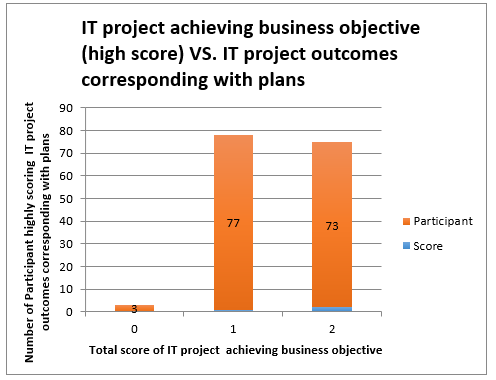
Chart 2: The high score part of IT project outcomes corresponding with plans correlates to project’s business objective achievement
The chart above shows that IT project achieving business objective was distributed highly at medium and high scores (77 and 73 participants correspondingly) while only a few of participants has given low scores. It means that IT project outcomes are corresponding with plans better influenced in business objectives of IT project than budgets and timetables with overwhelming figures. This distribution led to better improvement on the total IT project performance as it balances values of project budget and schedule in the high scores. Consequently, the distribution of participant for score 3 in the overall IT project performance is dominant on data population, which is followed by the 4-6 score. The high scores (5-6 score) of the total IT project performance explained an impressive rate of data (36%). Based on the distribution of medium and high score of each IT project outcome, it is visible that IT project outcomes are corresponding with plans the most influenced by IT project business objectives, which is followed by IT project budget. The IT project’s timetable seemed flexible with the specified plans as participants thought that it could be changed to adapt to project situation.
From the diagrammatic representation above, the high scores suggest that most people gave the high score for the IT project outcomes. This finding is a clear show that the consequences of the IT project corresponding with the plans influenced the most IT project objectives. The number of participants who scored highly in the IT project outcomes corresponding to the plans with relation to the achieving of the business objectives are highly concentrated at the medium and the high scores. This strong correlation means that the IT project outcomes corresponding with the plans significantly influenced the business objectives even more than schedules and budgets. Having clear and well-defined objectives are important, crucial success factors for the success of the IT project. Realistic and definite goals come out plays a vital role in the success of the project, and it is one of the three critical success factors that are most cited: timetable, cost, and objectives. The study reveals that a successful project has realistic and clear goals. In addition to this, the realism of importance of the goals is proved by the project’s success. Contrary to this, the failed project also begins with clear goals, but they end up failing at senior level. Failure of this projects, therefore, does not present the realism of the objectives. Hence they cannot be successfully validated. This research work presents clear project as one of the critical success factors for each and every IT project. In the successful Information Technology Project, the customers of the project are usually much concerned with the set goals or objectives and hence there is a sense of responsibility concerning the goals defined by the whole team. These goals are usually set concerning the requirements of the end consumers.
The IT project outcomes corresponding to the plan can only correspond well with clearly and realistically defined goals. Since goals are usually at a high level, it might involve more than just one project to achieve. Some outcomes such as the new procedures, reorganization of departments, new training classes, and the modification of the rewards system of the company. Besides having a slight influence on the time, the goal is well achieved when such factors get considered. Mostly, the goals of IT projects reference benefit of an organization regarding the quality, speed, and cost. Even though the goals are not among the ten-step project definition, understanding the organization’s objectives that are anticipated to be accomplished in IT project are paramount. Objectives always refer to the deliverables of all the IT projects. Any IT project alignment strategy or model should follow one goal that continually optimizes the returns to an organization from the IT investments in that project, the capital, support, service, and maintenance among other IT expenditures. Usually, the key success factors for the alignment of the IT spending as well as the efforts with business needs is accountability and mutual leadership. The organization leaders must lead the IT projects while the CIOs must become the business leaders.
Regardless of the role of the IT project, it should also play a major part in the creation of business value. The IT agenda needs to be focused on the achievement of the business-related and not just IT-related metrics that can bring about an improvement in alignment. In addition to this, the organizations should be informed of their IT resources that are often neglected. Having the knowledge is important because the organization’s competitiveness depends heavily on the quality of the technology resources as well as whether these resources are efficient enough to achieve the changing market needs.
IT project outcomes corresponding with plans correlates to its total performance
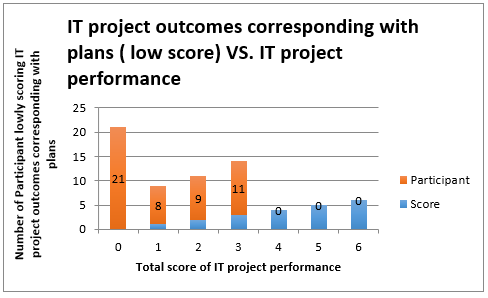
Chart 3: The low score part of IT project outcomes corresponding with plans correlates to its total performance.
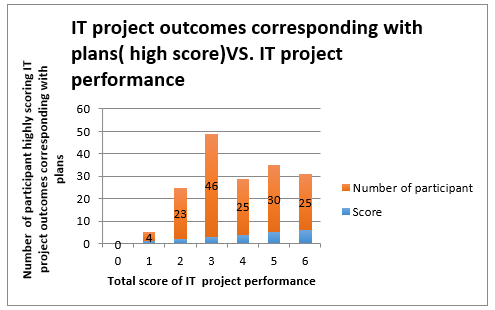
Chart 4. The high score part of IT project outcomes corresponding with plans correlates to its overall performance.
Charts 3 and 4 show that only a small number of participant scored the IT project outcomes corresponding with the plans with a score of 1 on the IT project performance. The scores obtained from the participants as shown in the diagram is a clear indication that the IT project outcomes corresponding with the plans positively impact on the project performance. Total IT project performance is evaluated by considering the summation of the IT projects keeping their timetables, the project meeting the business objectives, and the project falling within the set budget. There is no single parameter for measuring the performance of an IT project. The appropriate action for this aspect is by considering the outcomes of the IT project corresponding to the expected performance and lies with the project plan. This measures, however, will highly depend on the technology, strategy, and the environment or industry within which they get completed within the organization. The key aspect is the alignment to the strategic goals of business. The performance metrics of a project are therefore necessary for benchmarking the projects efficiency. In project management, the key performance indicators consist of different measurement tools to assess the attainment of the set objectives by the IT project. A project with better performance meets various aspects related to the cost, budget, and the timetable or schedule. Scope and the terms of an organization’s key performance indicators usually differ with the kind of project. The organization should, therefore, employ different kinds of data in its assessment. Project schedule, labor cost, current resource allocation, current development backlog, and the estimate to the project completion are necessary for evaluating the IT project’s performance (PMI, 2010). Depending on the goals being aimed at, IT project managers should be able to identify specific tools that could help them become more effective in determining a more realistic and successful outcome for them and those who are expecting them to complete the task accordingly.
The IT project outcomes sometimes give rise to a deviation from the planned budget. Having a knowledge concerning where and why the budget of a project deviated in essential in the tracking down the waste and the efficiency. And for better planning for the unforeseen challenges likely to occur in most projects. Deviation of the planned schedule of work is typical of IT projects. This calls for a better understanding of the tasks that takes time. This information is very much necessary for the training and the consulting of time allocation. The deviation also comes about when there is lack of understanding of the teams needed to move beyond and above. It is crucial to have a better understanding the predictable patterns of a group is essential in the building of the reward program as well as the significant incentive and in the improvement in the time allocation plan before the commencement of the project.
Lastly, the IT project performance can have an influence on the budget. The cost variance results from the lack of better management of the financial management plan. Accurate and precise records associated with the cost difference helps in providing a more detailed profile through which the teams and other processes are made more efficient. Also, it helps the organization’s in deciding whether a project is worth being implemented and the kind of assistance it offers to the managers regarding making decisions of initiating similar projects.
IT Project Plans Correlates to Project Budget
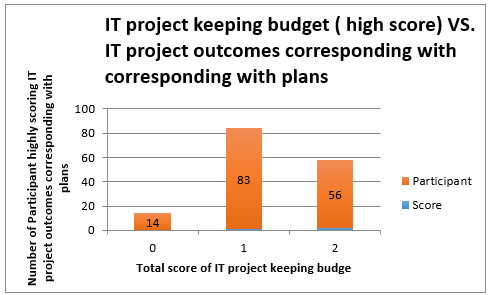
Chart 5. The high score part of IT project plans correlates to project budget.
The chart above shows that IT project keeping a budget is distributed more in the medium score (score 1) than the high score (score 2) approximately 37% of some participants. Thus, IT project outcomes corresponding with plans has moderate influence in IT project’ s budget and better impact on expense than on IT project’s timetable as some participants chose the high scores for project budgets more than project schedules. Budget is the key constraint to the IT projects (Kwak, 2005). The budget usually limits the ability of the project teams to obtain the required resources that are most likely to hinder the project’s scope. Sometimes, the cost of training the users of the newly implemented system might be high, and thus the budget needs to be extended. IT project constraints restrict the actions performed on the project as well as dictating the measures taken by the project team. The project managers should, therefore, can manage these constraints that sometimes demands some form of creativity. The key constraints as discussed above are budget, time, and quality. Time constraint is usually encountered as in the forms of enforced deadline that is commonly referred to as the make it happens now scenario (Catami, et al, 2011). In IT project planning and implementation, the tie constraint is typically the actual time needed to produce the deliverable. In this instance, the deliverables are the end results obtained from the project. Usually, the time required to produce the deliverables id directly related to the requirements that are the part of the scope or the result together with some allocated resources for a project that is measured regarding the cost. The cost gives the estimation of the amount of cash needed for the completion of the project. The cost encompasses some things including the resources, risk estimates, labor rates, and bill among others. All the aspects of any given IT project that has the monetary component are considered as part of the overall cost structure. The scope consists of the functional elements which make up the deliverables at the end of the project. Scope provides the project with higher chances of success. As demonstrated by the triple constraint triangle, it is impossible to alter or adjust one side of it minus affecting the other sides. The change in scope before the project gets fully executed automatically changes the time and cost on the other end in a particular manner.
Unlike other projects, where the project under development is seen physically, IT projects especially those one’s that concern the development of the software lacks the physical manifestation and therefore demands better tracking of the development schedule. Lack of such physical dimension of most IT projects makes it a little bit tougher tracking and monitoring it. Taking more time than the one allocated is one of the common sources of failure in the IT projects. Therefore, meeting the success of the project is likened to meeting the project schedule. This is a clear indication that schedule is the vital success factor. A better project schedule should, therefore, be realistic enough so that it is completed on time.
The quality of IT projects should be captured right from the beginning of the project. At this point, the expectations, as well as the quality standards of any given project, are established. Within a project’s course, it is too hard and late to amend any issue dealing with the quality, and this makes quality a critical factor in the success of the IT projects (Kwak, 2005). To ensure quality, the process of quality control becomes more relevant and is also considered a key success factor in the IT projects.
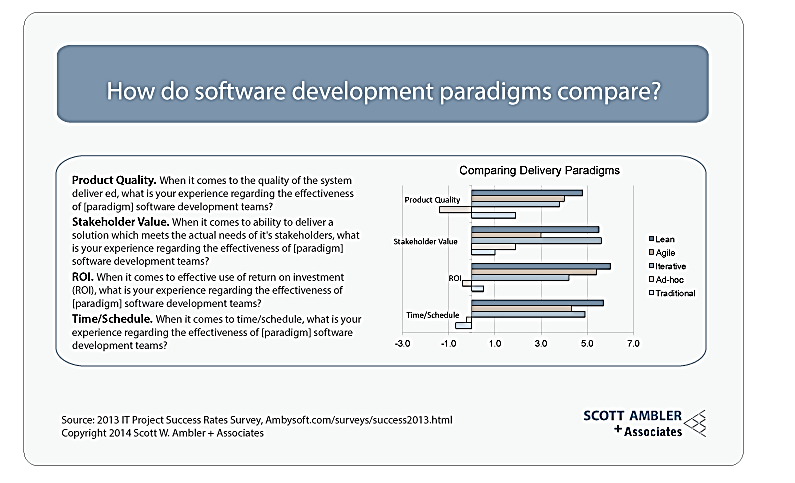
The presentation by Scott Ambler Associates as shown above gives a definite indication on how good it is for businesses to use to the IT project management approach to create a more productive result. The involvement of IT solutions within the project’s completion creates a more conductive pattern of return of investment for many business organizations. With high satisfactory response from the stakeholders, IT solutions applied in project management approaches provided a more consistent pattern of success among business owners that directly involves higher rate of return of investments. With proper control of factors that are involved in completing these projects, IT solutions increase the competency of organizations to provide what their stakeholders require.
An IT project’s success is assessed through considering some metrics which include meeting some key evaluation criteria. The first one is the adherence to specific requirements. Second is the timeliness of the agreed delivery. The last approach is compliance with the initial budget estimations (Cleland, et al, 2006). For a project to be deemed successful, it should meet all the three essential criteria. The challenged projects, therefore, are those that fails to comply with all or one of the key factors. The failed projects meet none of the three criteria.
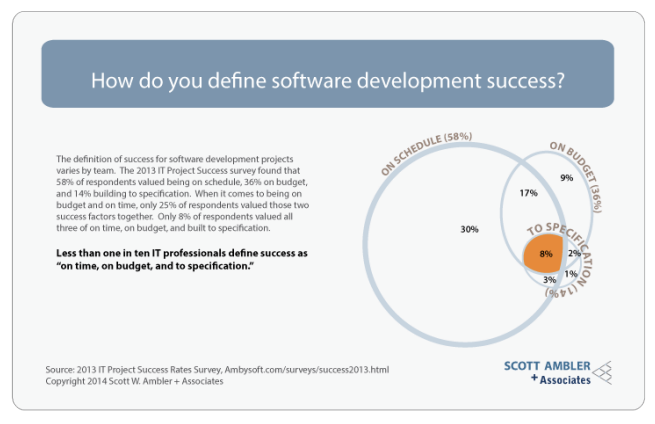
Source: http://dimsboiv.uqac.ca/8INF851/web/part1/problematique/IT_Survey_2013.pdf
Successful projects should involve all the key stakeholders including the users or the customer. Successful projects, therefore, takes care of the needs of their users in the process of system development. Even though there is little interaction with the end users, they still have a bigger say in the development process. In most failed projects, the users’ needs were ignored at some point of its development process and resulted in the lack of usability in the product. The budget, cost, and the scheduled date, therefore, interrelated and played a crucial role in the success of all IT projects.
Question 1
Ways that IT Outcomes as planned positively impact on the Project Budget
Regarding the way that IT project outcome as planned positively impact on IT projects budget, a limited number of companies recorded a compliance between the budgeted amount and the actual amount spent. Planning has proven to make the projects be delivered with minimum expense that does not deviate much from the budgeted amounts.
Question 2
Deliverable large Scale IT Project on time, on Budget and on Value
Research conducted in collaboration with University of Oxford indicates that almost half of large projects costing $15 million blow the budgets. The average over budget average value of projects is 45% and the overtime value is 7%. Most of the project also provide 56% less value than what is predicted. Also, it is noted that software project are the ones with the highest risk. The fact that the feature is consistent across a wide array of company further depict its validity of the hypothesis. It is also worth noting that the longer the projects the more likely they would go over-budget and overtime as implied in the figure below.
Evidence Against the Software Industry chaos
Further research comparing the effectiveness of software companies in the 5 paradigms gave rather amazing results. For the time schedule, 16% indicated preference for timely delivery, 39% regard readiness of delivery when the item is ready for shipping, while 42% percent regarded agreed that both are important. It was also noted that a 60 percent of manufacturers gave preference for providing a good Return on Investment. In the case of quality, 56% of companies preferred delivering high quality projects, indicating preference in production industry. However, most companies do not define success by the three deliverables but rather an independent consideration.
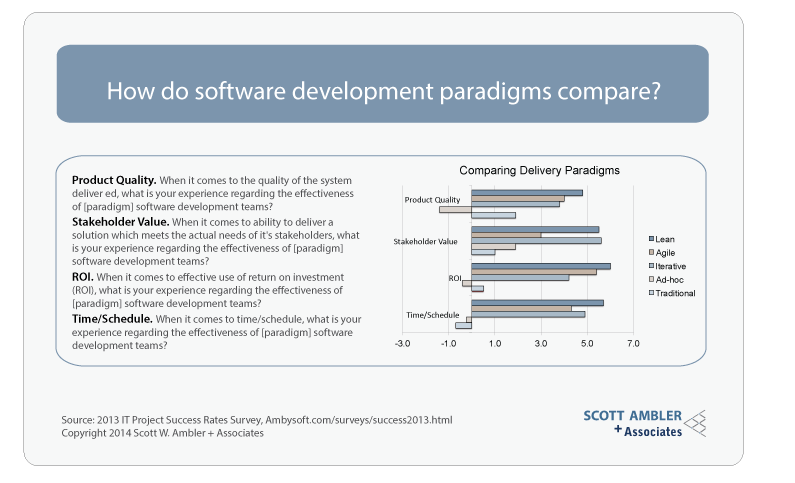
Comparing the effectiveness of the paradigms
Big Bang Boom
The project price is constituted of the project time, the project budget and specifications to be met. Therefore it means that the three parameters are interconnected. Most companies go a is by not considering their interrelation. More than 40% of the project indicated that the quality of a project is not always related to cost since one may have a high cost project that does not offer the required quality. It therefore needs that all the aspects are considered separately. The following figures indicate the relationship between the deliverables.
The Standish Group Report CHAOS
The research indicated that almost 31.1% of would be cancelled before reaching completion. I indicates that in future, IT projects will cost close to 189% of their original estimated cost. On the other side, only16.2% of IT projects are completed in time and within the set out budgets. Even though it is clear that IT projects quite go out of the planned requirements, most companies do not overshadow their project specifications to give space for a possible adjustment. Previous report indicates that a big percentage of IT projects would go over-board in terms of their cost by over 74.2% of their planned cost.
Cost Over Runs
Type 2 and type 3 projects almost experienced a 150-200% cost overrun. On average, the cost across companies increases by 189%. The cost overrun increases with the size of the company, in that large companies range at 178%, medium companies at 182%, and small companies at 214%. It is advisable to operate with companies then.
Time Overruns
Almost a third of the companies experience extreme time overrun of almost 300%. Again here the ranges are according to the size of the company. The average in this category is 220, with the company sizes evenly spread across. It can be noted that large companies are also time efficient compared to their small counterparts.
Content Deficiencies
For most of the troubled only 25% of the project was completed within the specifications of the original design. The highest completed value ranges at around 49%. In this category, large companies registered largest deviations from the original specifications, indicating that the large companies are weak in specification management. Therefore, IT project are having a difficulty in maintaining equilibrium between the cost, time and specification. The efficiency of an IT project is determined by its ability to meet the specified time, cost, and specifications.
Question 3
How Gaining Outcomes as Planned Leads to Overrun
Regarding whether IT projects tried to gain outcomes as planned, which led to project overrun on budget, some companies try to ensure that the amount quality and specifications of are maintained. The result is an overrun in the cost and time. If the others variables are kept constant, the quality and specifications are also liable to go on overrun.
Conclusion
Businesses in the modern world do so much to receive as much benefit from the effective use of IT in the process of completing projects that would provide extensive support to directive success of the organizations. In the process of internally involving IT solutions within the process of business success, it is shown in this discussion that time table and proper allocation of resources play a great role in making sure that each project succeeds. The effective management of time through setting up alternative resolutions to the possible problems that might arise during the project’s completion is necessary to create such response to development and proper direction of the project. The role of IT factors in improving how businesses address what they are expected to provide stakeholders who they are supposed to serve in the communities they are engaged with.
Works Cited
Cattani, G., Ferriani, S., Frederiksen, L. and Florian, T. (2011) Project-Based Organizing and Strategic Management, Advances in Strategic Management, Vol 28, Emerald.
Joseph Phillips (2003). PMP Project Management Professional Study Guide. McGraw-Hill Professional, 2003.
PMI (2010). A Guide to the Project Management Body of Knowledge p.27-35
Dennis Lock (2007) Project Management (9th ed.) Gower Publishing, Ltd., 2007. ISBN 0-566-08772-3
Young-Hoon Kwak (2005). “A brief History of Project Management”. In: The story of managing projects. Elias G. Carayannis et al. (9 eds), Greenwood Publishing Group, 2005.
David I. Cleland, Roland Gareis (2006). Global Project Management Handbook. “Chapter 1: “The evolution of project management”. McGraw-Hill Professional, 2006.

Time is precious
don’t waste it!

Plagiarism-free
guarantee

Privacy
guarantee

Secure
checkout

Money back
guarantee






